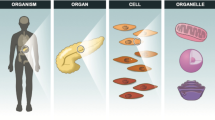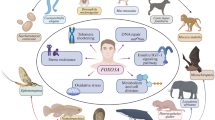Abstract
Healthspan is a complex trait, influenced by many genes and environmental factors that accelerate or delay aging, reduce or increase disease risk, and extend or reduce lifespan. Thus, assessing the role of genetic variation in aging requires an experimental strategy capable of modeling the genetic and biological complexity of human populations. The goal of the The Jackson Laboratory Nathan Shock Center (JAX NSC) is to provide research resources and training for geroscience investigators that seek to understand the role of genetics and genetic diversity on the fundamental process of aging and diseases of human aging using the laboratory mouse as a model system. The JAX NSC has available novel, deeply characterized populations of aged mice, performs state-of-the-art phenotyping of age-relevant traits, provides systems genetics analysis of complex data sets, and provides all of these resources to the geroscience community. The aged animal resources, phenotyping capacity, and genetic expertise available through the JAX NSC benefit the geroscience community by fostering cutting-edge, novel lines of research that otherwise would not be possible. Over the past 15 years, the JAX NSC has transformed aging research across the geroscience community, providing aging mouse resources and tissues to researchers. All JAX NSC data and tools are publicly disseminated on the Mouse Phenome Database and the JAX NSC website, thus ensuring that the resources generated and expertise acquired through the Center are readily available to the aging research community. The JAX NSC will continue to enhance its ability to perform innovative research using a mammalian model to illuminate novel genotype–phenotype relationships and provide a rational basis for designing effective risk assessments and therapeutic interventions to boost longevity and disease-free healthspan.

Similar content being viewed by others
References
Schoenmaker M, de Craen AJ, de Meijer PH, Beekman M, Blauw GJ, Slagboom PE, et al. Evidence of genetic enrichment for exceptional survival using a family approach: the Leiden Longevity Study. Eur J Hum Genet. 2006;14(1):79–84. https://doi.org/10.1038/sj.ejhg.5201508.
Broer L, Buchman AS, Deelen J, Evans DS, Faul JD, Lunetta KL, et al. GWAS of longevity in CHARGE consortium confirms APOE and FOXO3 candidacy. J Gerontol A Biol Sci Med Sci. 2015;70(1):110–8. https://doi.org/10.1093/gerona/glu166.
Murabito JM, Yuan R, Lunetta KL. The search for longevity and healthy aging genes: insights from epidemiological studies and samples of long-lived individuals. J Gerontol A Biol Sci Med Sci. 2012;67(5):470–9. https://doi.org/10.1093/gerona/gls089.
Newman AB, Walter S, Lunetta KL, Garcia ME, Slagboom PE, Christensen K, et al. A meta-analysis of four genome-wide association studies of survival to age 90 years or older: the Cohorts for Heart and Aging Research in Genomic Epidemiology Consortium. J Gerontol A Biol Sci Med Sci. 2010;65(5):478–87. https://doi.org/10.1093/gerona/glq028.
Timmers PR, Mounier N, Lall K, Fischer K, Ning Z, Feng X, et al. Genomics of 1 million parent lifespans implicates novel pathways and common diseases and distinguishes survival chances. Elife. 2019;8:e39856. https://doi.org/10.7554/eLife.39856.
Collaborative CC. The genome architecture of the Collaborative Cross mouse genetic reference population. Genetics. 2012;190(2):389–401. https://doi.org/10.1534/genetics.111.132639.
Churchill GA, Gatti DM, Munger SC, Svenson KL. The Diversity Outbred mouse population. Mamm Genome. 2012;23(9–10):713–8. https://doi.org/10.1007/s00335-012-9414-2.
Chocron ES, Munkacsy E, Pickering AM. Cause or casualty: the role of mitochondrial DNA in aging and age-associated disease. Biochim Biophys Acta Mol Basis Dis. 2019;1865(2):285–97. https://doi.org/10.1016/j.bbadis.2018.09.035.
Srivastava A, Morgan AP, Najarian ML, Sarsani VK, Sigmon JS, Shorter JR, et al. Genomes of the mouse Collaborative Cross. Genetics. 2017;206(2):537–56. https://doi.org/10.1534/genetics.116.198838.
Ackert-Bicknell CL, Anderson LC, Sheehan S, Hill WG, Chang B, Churchill GA, et al. Aging research using mouse models. Curr Protoc Mouse Biol. 2015;5(2):95–133. https://doi.org/10.1002/9780470942390.mo140195.
Sukoff Rizzo SJ, Anderson LC, Green TL, McGarr T, Wells G, Winter SS. Assessing healthspan and lifespan measures in aging mice: optimization of testing protocols, replicability, and rater reliability. Curr Protoc Mouse Biol. 2018;8(2):e45. https://doi.org/10.1002/cpmo.45.
Mesner LD, Calabrese GM, Al-Barghouthi B, Gatti DM, Sundberg JP, Churchill GA, et al. Mouse genome-wide association and systems genetics identifies Lhfp as a regulator of bone mass. PLoS Genet. 2019;15(5):e1008123. https://doi.org/10.1371/journal.pgen.1008123.
Ouellette AR, Neuner SM, Dumitrescu L, Anderson LC, Gatti DM, Mahoney ER, et al. Cross-species analyses identify Dlgap2 as a regulator of age-related cognitive decline and Alzheimer’s dementia. Cell Rep. 2020;32(9):108091. https://doi.org/10.1016/j.celrep.2020.108091.
Yuan R, Musters CJM, Zhu Y, Evans TR, Sun Y, Chesler EJ, et al. Genetic differences and longevity-related phenotypes influence lifespan and lifespan variation in a sex-specific manner in mice. Aging Cell. 2020;19(11):e13263. https://doi.org/10.1111/acel.13263.
Thompson MJ, Chwialkowska K, Rubbi L, Lusis AJ, Davis RC, Srivastava A, et al. A multi-tissue full lifespan epigenetic clock for mice. Aging (Albany NY). 2018;10(10):2832–54. https://doi.org/10.18632/aging.101590.
Bogue MA, Churchill GA, Chesler EJ. Collaborative Cross and Diversity Outbred data resources in the Mouse Phenome Database. Mamm Genome. 2015;26(9–10):511–20. https://doi.org/10.1007/s00335-015-9595-6.
Takemon Y, Chick JM, GerdesGyuricza I, Skelly DA, Devuyst O, Gygi SP, et al. Proteomic and transcriptomic profiling reveal different aspects of aging in the kidney. Elife. 2021;10:e62585. https://doi.org/10.7554/eLife.62585.
Haque S, Ames RM, Moore K, Pilling LC, Peters LL, Bandinelli S, et al. circRNAs expressed in human peripheral blood are associated with human aging phenotypes, cellular senescence and mouse lifespan. Geroscience. 2020;42(1):183–99. https://doi.org/10.1007/s11357-019-00120-z.
Yu W, Ackert-Bicknell C, Larigakis JD, MacIver B, Steers WD, Churchill GA, et al. Spontaneous voiding by mice reveals strain-specific lower urinary tract function to be a quantitative genetic trait. Am J Physiol Renal Physiol. 2014;306(11):F1296–307. https://doi.org/10.1152/ajprenal.00074.2014.
Whitehead JC, Hildebrand BA, Sun M, Rockwood MR, Rose RA, Rockwood K, et al. A clinical frailty index in aging mice: comparisons with frailty index data in humans. J Gerontol A Biol Sci Med Sci. 2014;69(6):621–32. https://doi.org/10.1093/gerona/glt136.
An JY, Kerns KA, Ouellette A, Robinson L, Morris HD, Kaczorowski C, et al. Rapamycin rejuvenates oral health in aging mice. Elife. 2020;9:e54318. https://doi.org/10.7554/eLife.54318.
Bogue MA, Grubb SC, Walton DO, Philip VM, Kolishovski G, Stearns T, et al. Mouse Phenome Database: an integrative database and analysis suite for curated empirical phenotype data from laboratory mice. Nucleic Acids Res. 2018;46(D1):D843–50. https://doi.org/10.1093/nar/gkx1082.
Noordmans GA, Caputo CR, Huang Y, Sheehan SM, Bulthuis M, Heeringa P, et al. Genetic analysis of mesangial matrix expansion in aging mice and identification of Far2 as a candidate gene. J Am Soc Nephrol. 2013;24(12):1995–2001. https://doi.org/10.1681/ASN.2012080838.
Noordmans GA, Huang Y, Savage H, van Dijk MC, Schaart G, van den Bergh Weerman MA, et al. Genetic analysis of intracapillary glomerular lipoprotein deposits in aging mice. PLoS ONE. 2014;9(10):e111308. https://doi.org/10.1371/journal.pone.0111308.
Huang Y, Caputo CR, Noordmans GA, Yazdani S, Monteiro LH, van den Born J, et al. Identification of novel genes associated with renal tertiary lymphoid organ formation in aging mice. PLoS ONE. 2014;9(3):e91850. https://doi.org/10.1371/journal.pone.0091850.
Sheehan S, Mawe S, Cianciolo RE, Korstanje R, Mahoney JM. Detection and classification of novel renal histologic phenotypes using deep neural networks. Am J Pathol. 2019;189(9):1786–96. https://doi.org/10.1016/j.ajpath.2019.05.019.
Sheehan SM, Korstanje R. Automatic glomerular identification and quantification of histological phenotypes using image analysis and machine learning. Am J Physiol Renal Physiol. 2018;315(6):F1644–51. https://doi.org/10.1152/ajprenal.00629.2017.
Snyder JM, Snider TA, Ciol MA, Wilkinson JE, Imai DM, Casey KM, et al. Validation of a geropathology grading system for aging mouse studies. Geroscience. 2019;41(4):455–65. https://doi.org/10.1007/s11357-019-00088-w.
Funding
This work was supported by the National Institutes of Health grant to The Jackson Laboratory Nathan Shock Center of Excellence in the Basic Biology of Aging (AG038070).
Author information
Authors and Affiliations
Corresponding author
Additional information
Publisher's note
Springer Nature remains neutral with regard to jurisdictional claims in published maps and institutional affiliations.
About this article
Cite this article
Korstanje, R., Peters, L.L., Robinson, L.L. et al. The Jackson Laboratory Nathan Shock Center: impact of genetic diversity on aging. GeroScience 43, 2129–2137 (2021). https://doi.org/10.1007/s11357-021-00421-2
Received:
Accepted:
Published:
Issue Date:
DOI: https://doi.org/10.1007/s11357-021-00421-2




